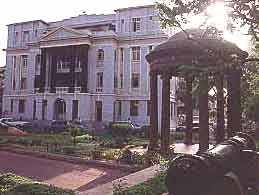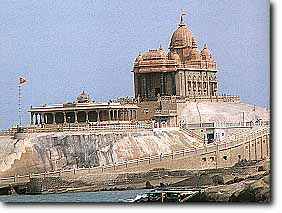India > Forts & Monuments > Tamil Nadu
TAMIL NADU
Fort of St. George, Chennai

Fort St. George was among the first few bastions built by the East India Company somewhere around 1635 to protect its interests in India from rival companies. This fortification also marks the making of Chennai (Madras) as a modern city. The fort has a museum which displays many items from the British Raj and memorabilia of the East India Company. These relics are a reminder of a period of oppression and struggle. The museum also has a good collection of some fine contemporary paintings. Within the fort premises is the oldest surviving British church in India, St. Mary's Church. This church is also the first English church in Chennai. St. Mary's was the venue for the marriage of Lord Clive. Towards the North of the fort is the High Court compound which is build in Indo-Sarcenic architectural style. Within this compound stands the lighthouse erected in 1844, which was superseded by another one in 1971. The latter is, however, not so impressive.
Vivekanand Rock Memorial, Kanyakumari

On the sea side of Kanyakumari is built a large, beautiful memorial dedicated to Swami Vivekanand. Here Swami Vivekananda did his meditation. The memorial was built in 1970. It houses a huge metal statue of Vivekananda. To reach this memorial one has to take the ferry services or boats plying between the rock memorial and the mainland. The merger of three seas - Bay of Bengal, Arabian sea and the Indian ocean can be seen from these rocks. While looking at the horizon, one gets a feeling that nature has sprayed various colors on water. Though the structure is well constructed, it has been very badly maintained.
Tanjavur Palace
Near the temple are huge masonry structure which were partly built by the Nayaks in 1550 and partly by the Marathas. The Tanjavur palace, as it is known, has huge halls, spacious corridors, observation & arsenal towers and a shady courtyard. Though many sections of the palace are in ruins restoration work has been taken up. The palace houses a library, a museum and an art gallery. The Royal museum displays many items from the kings who ruled the place in past. The eclectic collection of royal memorabilia can fascinate any visitor. The Royal cloths, hunting weapons, the head gears and many more such items are enough to catch the attention of any one. There are two Durbar halls where the rulers held public meetings. Though they have not been renovated, they are in good shape. The Nayak hall of the palace is occupied by the Art Gallery. This gallery has an excellent collection of artifacts from the Chola dynasty during the 8th and 9th century. The bronze and granite statues reflect the height of craftsmanship obtained during those days. The bell tower which was put under restoration work, has emerged very different from the rest of the structure after renovation. But it is worth going up the tower to have a good view of the surrounding area. Next to the art gallery is the Saraswathi Mahal Library with an amazing collection of manuscripts on palm leaves and paper. The library is not open for the public. But one can always go in the museum to have a look at the full Ramayana written on Palm leaf or a set of explicit prints of prisoners under Chinese torture.

